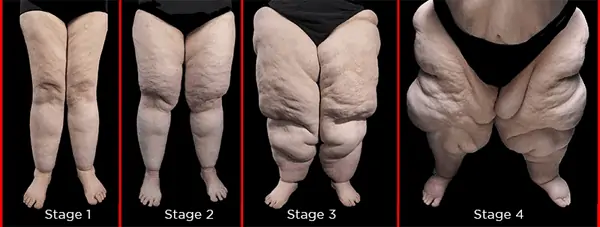LIPEDEMA TREATMENT
- Homepage
- AESTHETIC SURGERY
- Body
- LIPEDEMA TREATMENT
Lipedema Treatment
Lipedema is a condition which represents an abnormality of fat cells of the extremities. The fat cells in Lipedema undergo enlargement and develop edema or increased fluid collection. This condition affects primarily women in the third decade of life but can occur anytime after puberty, and affects 11% of the female population. Many women who suffer with Lipedema are not aware that it is a medical condition rather than obesity, and many medical professionals are unaware of this condition as well. The hallmark of Lipedema is fatty enlargement of the legs and often the arms, sparing the trunk, hands and feet. Women with Lipedema look disproportionate with normal-appearing torsos and enlarged lower body and arms. Many have worked hard with diet and exercise and even bariatric surgery, none of which will improve Lipedema.
Because of the confusion and lack of knowledge in the medical community, patients are often shuttled from doctor to doctor and subjected to unfair judgement relating to “obesity” and lifestyle choices that are truly unrelated to this condition. This is an autosomal dominant disease which means that it is carried on one of the first 22 non-sex autosomal chromosomes. Since Lipedema affects primarily women (only two cases have been reported in men), each female child of a mother who carries the gene has a 50% chance of developing Lipedema.
- Symptoms
- Stages of Lipedema
- Types of Lipedema
- Treatment of Lipedema
The abnormal fat cells in Lipedema continue to enlarge as the disease progresses resulting in weight gain, generalized pain in the extremities and feet, and painful nodules. The extremities can develop a nodular appearance with easy bruising, tenderness to the touch, and swelling that is non-pitting. Although seen primarily in the buttocks and lower extremities, Lipedema can affect the arms in 30% of patients . Many patients develop pain either on the sole of the foot or the dorsum or top of the foot. It is not clear what causes this pain and various treatments have limited effect.
Patients with Lipedema are often confused as having lymphedema (swelling of the extremities with malfunctioning lymphatic system) or generalized lifestyle-induced obesity. The hallmark of Lipedema is enlargement of fat cells of the buttocks, hips and legs that abruptly stops just above the ankles. Whereas Lymphedema can involve the feet, Lipedema does not, and there is an absence of the “Stemmer Sign” which is the inability to pinch the skin of the foot due to swelling of the skin seen in Lymphedema. As Lipedema progresses, patients can develop pain and swelling in the legs and arms, rendering them immobile and greatly limiting daily activities.
STAGE 1
Smooth skin with an increase of enlarged subcutaneous fat tissue.
STAGE 2
Uneven skin with indentations in the fat tissue and larger mounds of fat tissue (lipomas) able to be seen and felt.
STAGE 3
Large extrusion of fat tissue causing deformations especially on the thighs and around the knees.
STAGE 4
Development of lipolymphedema — a condition where both lipedema and lymphedema are present in the body — with large overhangs of tissue on legs and/or arms.
Type 1: Buttocks and hips.
Type 2: Buttocks to knees with folds around the knee.
Type 3: Buttocks to ankles.
Type 4: Arms.
Type 5: Isolated to lower leg.
The goals for treatment include:
- Reduction and in many cases the elimination of inflammation, swelling and pain.
- Increase in lymphatic flow which reduces/eliminates excessive fluid and the swelling that comes along with it.
- Overall management of the physical impact of lipedema.
- Quality of life which can include emotional, psychological/mental, spiritual and social enhancement in addition to physical management.
Conservative Therapy:
- Manual Lymphatic Drainage (MLD)
Manual Lymphatic Drainage is a unique therapeutic method of stimulating lymphatic fluid movement in the tissues. MLD is a gentle, rhythmic massage that follows the direction of lymph flow and can reduce swelling almost immediately. It assists the lymphatic system in removing fluids, waste products, protein particles and debris. MLD can also be used to break up fibrosis in a limb with lymphedema.
- Exercise/Movement
Exercise, like diet, is important for maintaining overall health even though it is not effective in reducing lipedema fat. Lipedema patients often find swimming to be a great low-impact activity, as more vigorous activities like running are often too painful.
Surgical Therapy:
- Liposuction
To date, there is no alternative to Liposuction for the permanent removal of fat cells. This procedure has been become possible for lipoedema in the last 20 years through the development of tissue-friendly techniques.
So far, in the case of two techniques it has been proved that lymphatic vessels in particular are not injured:
- Water Jet-Assisted Liposuction
- Vaser Liposuction
